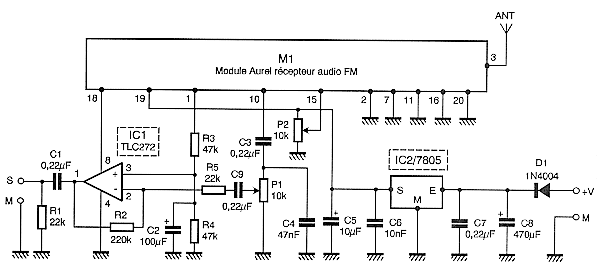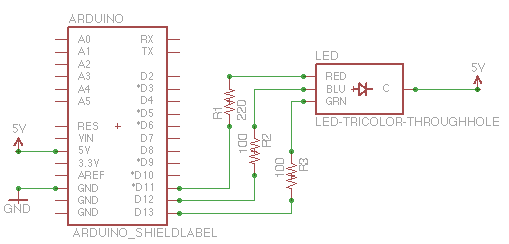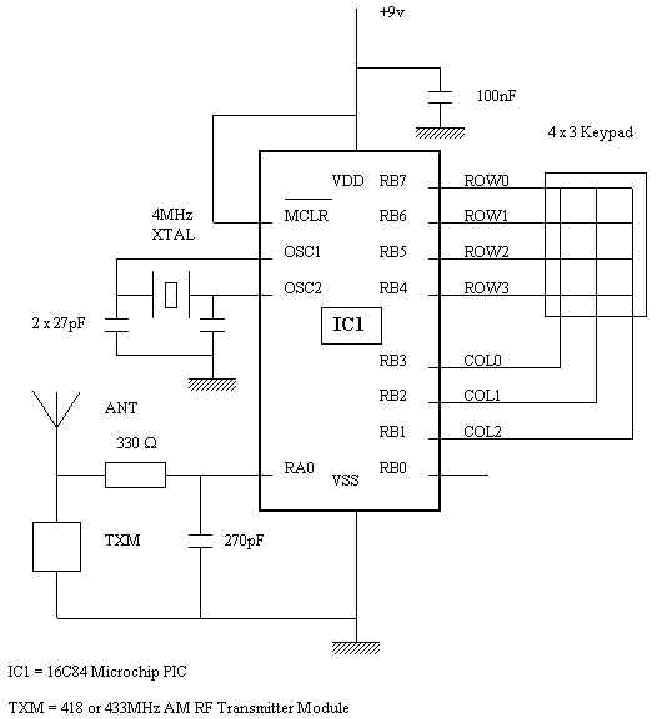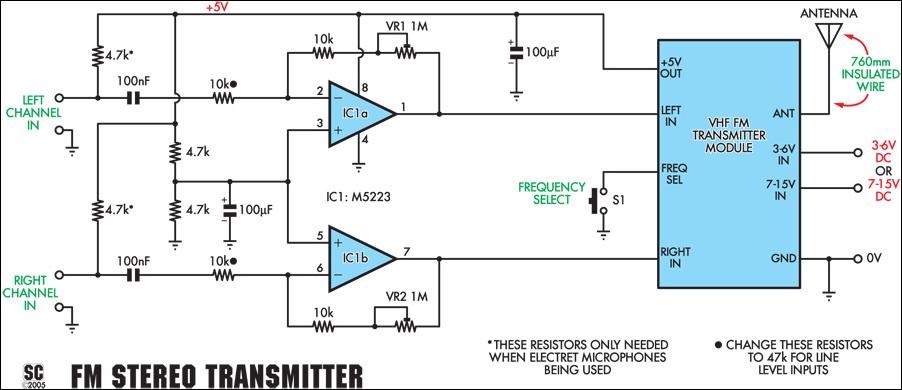
FM Wireless Mike
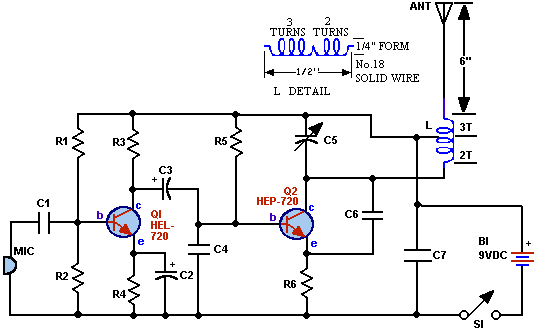
The FM wireless microphone is a compact electronic project centered around a radio transmitter. It serves as an innovative means of communication, allowing users to converse with friends over distances of up to 50 feet, potentially extending to 100 feet under favorable conditions. The audio is received using a standard FM radio. The microphone preamplifier functions as a basic audio amplifier, utilizing transistor Q1 in voltage divider mode. A dynamic microphone is employed within the amplifier, where the small alternating current generated by the microphone is amplified and transmitted to the FM transmitter. The FM transmitter operates as a tuned collector radio frequency oscillator. A coil and trimmer capacitor form a parallel tank circuit, tuned to resonate within the FM radio band of 88-108 MHz. The oscillator maintains a constant resonant frequency, with the ability to adjust the operating frequency by varying the trimmer capacitance. To achieve frequency modulation (FM), the audio signal from the amplifier is applied to the base of the oscillator's transistor. The base-emitter junction functions like a diode, and the applied signal alters the voltage across the junction. This specific transistor exhibits a property that changes the base capacitance in response to the input voltage, effectively modifying the capacitance in series with the resonant tank circuit and thus altering the operating frequency. This process results in FM modulation, with the modulated signal being transmitted through a small radio antenna.
The FM wireless microphone project involves several key components that work together to facilitate effective communication. The dynamic microphone captures audio signals, converting them into small alternating currents. These currents are then amplified by the microphone preamplifier, which utilizes a transistor in voltage divider mode to increase the signal strength before it is sent to the FM transmitter.
The FM transmitter itself is designed as a tuned collector radio frequency oscillator, which is essential for generating the radio waves that carry the audio signal. The parallel tank circuit, composed of a coil and a trimmer capacitor, is critical for determining the resonant frequency of the oscillator. By adjusting the trimmer capacitor, the user can fine-tune the operating frequency to ensure it falls within the standard FM band, allowing compatibility with common FM radios.
When the audio signal from the preamplifier is applied to the base of the transistor in the oscillator, it induces changes in the base-emitter junction voltage. This alteration causes variations in the capacitance at the base, which directly affects the resonant frequency of the tank circuit. As the capacitance changes, the frequency of the transmitted signal shifts accordingly, resulting in frequency modulation of the audio signal.
The final output of this system is broadcasted via a compact radio antenna, enabling the transmission of audio signals over considerable distances. The design emphasizes simplicity and effectiveness, making it an excellent project for those interested in exploring the principles of radio frequency transmission and audio modulation.FM wireless Mike is a small electronic project based on a radio transmitter. It is a wonderful idea to make a wacky talky through which you can talk to your friend, next door. Just speak or play into the microphone and you ’ll broadcast to an FM receiver at distances up to 50 feet (maybe 100 feet if the wind is right). Use a standard FM radio to r eceive the sound. Microphone Preamplifier is a simple audio amplifier. Transistor Q1 is operated in Voltage Divider Mode. We use a dynamic microphone in the amplifier. The small alternating current produced in the microphone is amplified and fed in to the FM transmitter. FM transmitter is a tuned collector radio frequency oscillator. The coil and trimmer is in parallel tank circuit. We specify the value of trimmer and size of the coil such that the resonant frequency will be near 88-108 MHz (in the FM radio Band).
The oscillator oscillates with a constant resonant frequency and we can change the operating frequency by changing the trimmer capacitance. This frequency is the center frequency of the FM. If we want the FM as a modulation we have to apply the modulating signal (audio signal from amplifier) to the base of the transistor of the oscillator.
We all know the base-emitter junction acts like a diode. If we apply the signal the voltage across the junction will change and this particular transistor have some property of changing base capacitance according to the applied input voltage. Thus we change the capacitance which is in series with the resonant tank circuit causing a change in operating frequency.
This is actually the FM modulation. Now the modulated signal will be transmitted via a small radio antenna. 🔗 External reference
The FM wireless microphone project involves several key components that work together to facilitate effective communication. The dynamic microphone captures audio signals, converting them into small alternating currents. These currents are then amplified by the microphone preamplifier, which utilizes a transistor in voltage divider mode to increase the signal strength before it is sent to the FM transmitter.
The FM transmitter itself is designed as a tuned collector radio frequency oscillator, which is essential for generating the radio waves that carry the audio signal. The parallel tank circuit, composed of a coil and a trimmer capacitor, is critical for determining the resonant frequency of the oscillator. By adjusting the trimmer capacitor, the user can fine-tune the operating frequency to ensure it falls within the standard FM band, allowing compatibility with common FM radios.
When the audio signal from the preamplifier is applied to the base of the transistor in the oscillator, it induces changes in the base-emitter junction voltage. This alteration causes variations in the capacitance at the base, which directly affects the resonant frequency of the tank circuit. As the capacitance changes, the frequency of the transmitted signal shifts accordingly, resulting in frequency modulation of the audio signal.
The final output of this system is broadcasted via a compact radio antenna, enabling the transmission of audio signals over considerable distances. The design emphasizes simplicity and effectiveness, making it an excellent project for those interested in exploring the principles of radio frequency transmission and audio modulation.FM wireless Mike is a small electronic project based on a radio transmitter. It is a wonderful idea to make a wacky talky through which you can talk to your friend, next door. Just speak or play into the microphone and you ’ll broadcast to an FM receiver at distances up to 50 feet (maybe 100 feet if the wind is right). Use a standard FM radio to r eceive the sound. Microphone Preamplifier is a simple audio amplifier. Transistor Q1 is operated in Voltage Divider Mode. We use a dynamic microphone in the amplifier. The small alternating current produced in the microphone is amplified and fed in to the FM transmitter. FM transmitter is a tuned collector radio frequency oscillator. The coil and trimmer is in parallel tank circuit. We specify the value of trimmer and size of the coil such that the resonant frequency will be near 88-108 MHz (in the FM radio Band).
The oscillator oscillates with a constant resonant frequency and we can change the operating frequency by changing the trimmer capacitance. This frequency is the center frequency of the FM. If we want the FM as a modulation we have to apply the modulating signal (audio signal from amplifier) to the base of the transistor of the oscillator.
We all know the base-emitter junction acts like a diode. If we apply the signal the voltage across the junction will change and this particular transistor have some property of changing base capacitance according to the applied input voltage. Thus we change the capacitance which is in series with the resonant tank circuit causing a change in operating frequency.
This is actually the FM modulation. Now the modulated signal will be transmitted via a small radio antenna. 🔗 External reference

